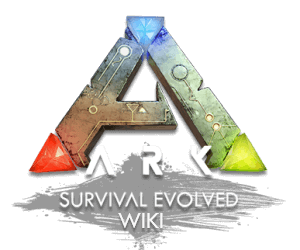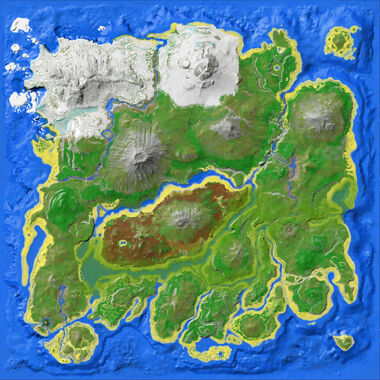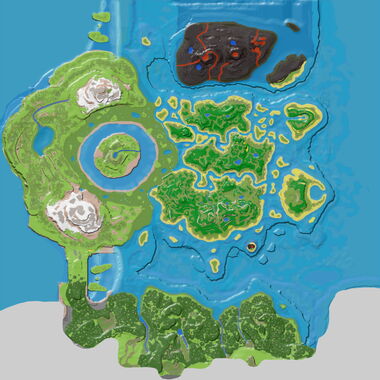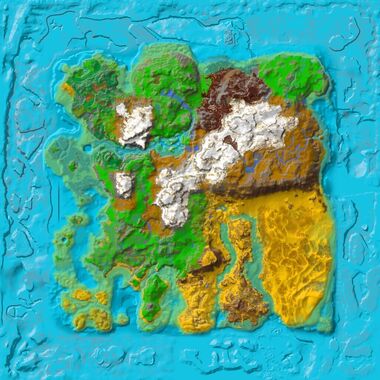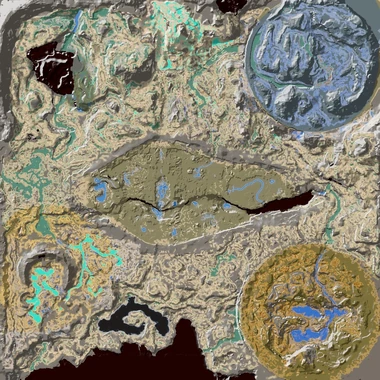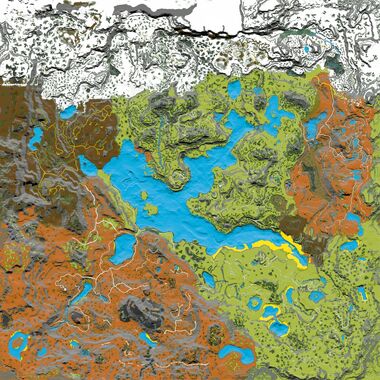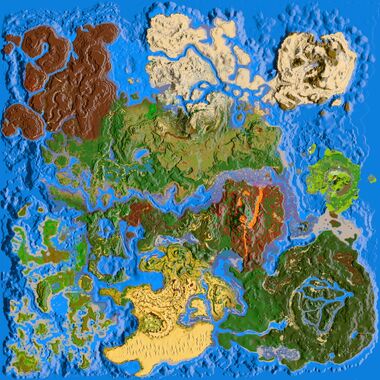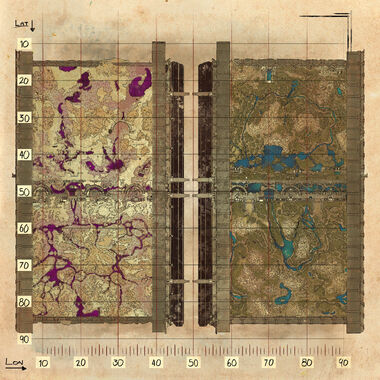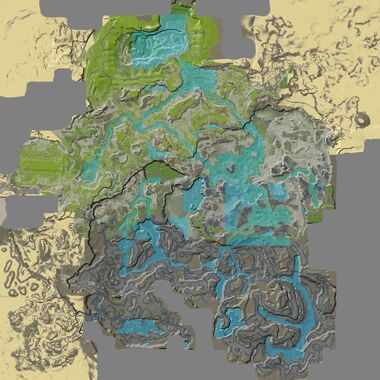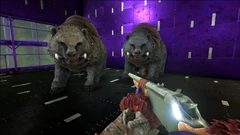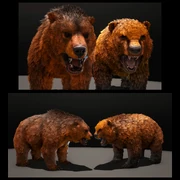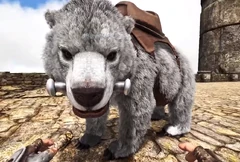Will130Bot (discusión | contribs.) m (Updated MissingTranslations) |
UmbralExcalibur (discusión | contribs.) m (FandomDesktop fix: Adjusting infobox spawn map sizes) |
||
| Línea 54: | Línea 54: | ||
<tabber> |
<tabber> |
||
Dire Bear= |
Dire Bear= |
||
| − | {{SpawningMap |
+ | {{SpawningMap|nolegend=true|species=Dire Bear}} |
|-| |
|-| |
||
Polar Bear= |
Polar Bear= |
||
| − | {{SpawningMap |
+ | {{SpawningMap|nolegend=true|species=Polar Bear}} |
|-| |
|-| |
||
Dire Polar Bear= |
Dire Polar Bear= |
||
| − | {{SpawningMap |
+ | {{SpawningMap|nolegend=true|species=Dire Polar Bear}} |
|-| |
|-| |
||
Aberrant Dire Bear= |
Aberrant Dire Bear= |
||
| − | {{SpawningMap |
+ | {{SpawningMap|nolegend=true|species=Aberrant Dire Bear}} |
</tabber> |
</tabber> |
||
{{RarityLegend|370}} |
{{RarityLegend|370}} |
||
Revisión del 23:14 8 jul 2021
| Este artículo es un esbozo. Puedes ayudar a completar el artículo ampliándolo. |
| Esta es una traducción en progreso. El contenido y el formato de esta página pueden variar durante las próximas horas o días. |
Dosier
Esta sección pretende ser una copia exacta de lo que ha escrito el superviviente Helena Walker, autor(a) de los dossiers. Puede haber algunas discrepancias entre este texto y la criatura del juego.creature.
Descripción
Comportamiento
The Oso Gigante is an omnivore, meaning it can eat both berries and meat. It is very territorial and will attack if not given enough space. It possesses a charging mechanic similar to that of the Pachy or Woolly Rhino. It can maneuver at high speeds, and takes a while to actually lose stamina by a significant amount. It possesses a secondary swipe attack that can be used to gather berries and pluck out meat from its target. This swipe additionally does more damage than normal, but stops movement. The Oso Gigante can also stand on its hind legs (crouching, default C).
Aspecto
The Oso Gigante is never a welcome sight for survivors in the frozen regions of the ARK. Resembling a grizzly bear in appearance, the Dire Bear is distinguishable by its shorter snout, earning it the nickname "Short-Faced Bear". Like other bears, they are capable of standing on their hind legs, but only to intimidate those that enter its territory. The beast is also surprisingly swift for its hulking build.
Color Scheme and Regions
This section displays the Oso Gigante's natural regions. For demonstration, the regions below are colored red over an albino Oso Gigante.
This information can be used to alter the Oso Gigante's regions by entering cheat SetTargetDinoColor <ColorRegion> <ColorID> in the cheat console. For instance, cheat SetTargetDinoColor 1 6 would color the Oso Gigante's "" magenta.

La región 1 no se usa
en esta criatura.

La región 1 no se usa
en esta criatura.

La región 2 no se usa
en esta criatura.

La región 3 no se usa
en esta criatura.

La región 4 no se usa
en esta criatura.

La región 5 no se usa
en esta criatura.
Variantes
Oso Polar
Los Osos Polares son la variante del Oso Gigante que habita en la Cueva de Nieve de The Island, y en la Cueva de Hielo en Extinction. No es posible domesticarlos, y tienen una Salud base de 800.
Dire Polar Bear
The Dire Polar Bear is a variant of Oso Gigante that can be found on the Ragnarok and more commonly on the Valguero map. It is identical to the normal Dire Bear in all aspects except for its white color.
Spirit Dire Bear
The Spirit Dire Bear is a variant of Dire Bear that can be found on the Ragnarok map as a dungeon boss in Life's Labyrinth. It will spawn in waves with the ![]() Spirit Direwolf beginning at level 50, and increasing its level every wave by 50, ending at level 250. It is identical to the Oso Gigante normal in all aspects except for its ghost-like appearance.
Spirit Direwolf beginning at level 50, and increasing its level every wave by 50, ending at level 250. It is identical to the Oso Gigante normal in all aspects except for its ghost-like appearance.
Drops
Base Stats and Growth
Ten en cuenta, que las estadísticas podrán variar en ARK:Survival of the fittest, y en ARK:Mobile
| Atributos | Cantidad a nivel 1 | Aumento por cada punto | Bonif. por domesticación | ||
|---|---|---|---|---|---|
| Salvaje | Domesticado1 | Add | Mult | ||
| 400 | +80 | +5.4% | 0.07 | ||
| 500 | +50 | +10% | |||
| 270 | +27 | +10% | |||
| 3000 | +300 | +10% | |||
| 650 | +13 | +4% | |||
| 50 / 652 | +2.5 / +3.25 | +1.7% | 7% | 17.6% | |
| 100% | N/A3 | +1% | 122.6% | ||
| 1000 | +60 | N/A4 | 0.5 | ||
1Los porcentajes se basan en el valor de la estadística al momento de ser domesticada (es decir, después de aplicarse la efectividad de tameo.)
2Aquí, se muestra el Daño base en bruto, en lugar de mediante porcentajes.
3Las criaturas salvajes no incrementan su velocidad de movimiento al subir de nivel.
4La Inconsciencia aumenta con los niveles, pero no puede ser subida manualmente una vez ha sido domesticada.
- Para ver una comparación de todas las estadísticas de las criaturas, consulta Estadísticas de criatura base.
- Para una explicación de cómo se calcula la subida de nivel, comprueba los cálculos de estadísticas para criaturas.
| Tipo de movimiento | Velocidad base | Corriendo | Energía usada | |
|---|---|---|---|---|
| Salvaje | Domesticado | |||
| Caminando | 190 | 961.875 | 1149.5 | 14 |
| Nadando | 360 | N/A | N/A | N/A |
- Estas son las velocidades base con un 100 % de velocidad de movimiento
- Para una comparación de todas las velocidades de movimiento, consulta Velocidad base de criaturas
| Stamina Cost | Attack Range | Description | |||||||||||
|---|---|---|---|---|---|---|---|---|---|---|---|---|---|
| Base | Minimum | Activation | |||||||||||
Aumento de estadísticas al subir nivel en estado salvaje
Escribe los valores de la criatura salvaje para revisar en que estadísticas sobresale más. Los valores marcados con verde en una criatura de alto nivel son muy buenos para la crianza/reproducción. Si ya has domesticado una criatura, puedes intentar recuperar la información que tenía cuando era salvaje con la siguiente herramienta: ARK Stats Extractor.
Ten en cuenta, que las estadísticas podrán variar en ARK:Survival of the fittest, y en ARK:Mobile
| Atributos | Cantidad a nivel 1 | Aumento por cada punto |
|---|---|---|
| Salvaje | ||
| 800 | +160 | |
| 500 | +50 | |
| 270 | +27 | |
| 3000 | +300 | |
| 650 | +13 | |
| 50 / 652 | +2.5 / +3.25 | |
| 100% | N/A3 | |
| 1000 | +60 |
1Los porcentajes se basan en el valor de la estadística al momento de ser domesticada (es decir, después de aplicarse la efectividad de tameo.)
2Aquí, se muestra el Daño base en bruto, en lugar de mediante porcentajes.
3Las criaturas salvajes no incrementan su velocidad de movimiento al subir de nivel.
4La Inconsciencia aumenta con los niveles, pero no puede ser subida manualmente una vez ha sido domesticada.
- Para ver una comparación de todas las estadísticas de las criaturas, consulta Estadísticas de criatura base.
- Para una explicación de cómo se calcula la subida de nivel, comprueba los cálculos de estadísticas para criaturas.
| Tipo de movimiento | Velocidad base | Corriendo |
|---|---|---|
| Salvaje | ||
| Caminando | 190 | 961.875 |
| Nadando | 360 | N/A |
- Estas son las velocidades base con un 100 % de velocidad de movimiento
- Para una comparación de todas las velocidades de movimiento, consulta Velocidad base de criaturas
| Stamina Cost | Attack Range | Description | |||||||||||
|---|---|---|---|---|---|---|---|---|---|---|---|---|---|
| Base | Minimum | Activation | |||||||||||
Taming
Plantilla:TamingInfo
KO Strategy
- Headshots do not give extra torpor for this tame, they are treated as body shots. Avoid headshots to avoid killing the tame.
- Any taming strategy will work. Taming pens, picking up, standing on rocks will do. Just make sure not to be on the low ground, as its high base damage will make short work of your character.
- Building a wall or platform to shoot from without being hit from the Oso Gigante is one way to ensure you're able to time your narcotic shots properly, which is very important since the Oso Gigante has very little health compared to torpor.
- Be aware that the Oso Gigante has very high torpor compared to their health. Monitoring the number and timing of
 Tranq Arrow you use is very important in order to prevent accidentally killing the Oso Gigante. This is because it takes 4 seconds for all the torpidity from a
Tranq Arrow you use is very important in order to prevent accidentally killing the Oso Gigante. This is because it takes 4 seconds for all the torpidity from a  Tranq Arrow to apply but only 2.61 seconds to reload a
Tranq Arrow to apply but only 2.61 seconds to reload a  ballesta.
ballesta.  Tranquilizer Dart or
Tranquilizer Dart or  Shocking Tranquilizer Dart are advised, as they have a much higher torpidity to damage ratio and the reload time on the
Shocking Tranquilizer Dart are advised, as they have a much higher torpidity to damage ratio and the reload time on the  Longneck Rifle is within half a second of the time it takes the darts to apply all their torpidity.
Longneck Rifle is within half a second of the time it takes the darts to apply all their torpidity. - One good strategy is to build a 2x2 foundation with 2-high door frames and a ramp leading to the top. lure the bear in by running up the ramp, jumping in, and running out the opposite end through the door frames. While tranqing , if using a ballesta/bow, place a box and a few beds nearby. Every 10-ish arrows, shove your gear into the box, run up to the cage, let the bear kill you (or drop/lure another creature to the cage), and make sure the corpse is eaten. You may have to drag the corpse to the bear afterwards to ensure it eats it. This ensures the bear heals from the damage done from the arrows. Make sure to feed it corpses every 10-ish arrows because once it gets visibly bloody, it will most likely have enough torpor that it will try to flee and it will never attack after that point. once this happens, all you can do is keep shooting and hope it doesn't die.
Taming Food
Error: No taming-data for "Oso Gigante" found. If the current page is not a creature-page, write the wanted creature as first parameter. Use only the common name, found on the creature's dossier.
Tenga en cuenta que los valores son para los casos óptimos, siempre llevar suministros adicionales!
Para obtener un valor más aproximado de los recursos necesarios, prueba Calculadoras externas de doma.
No hay resultados
Preferred Food
The Oso Gigante is an omnivore.
Combate
Can be stuck between trees or rocks, keep a distance and move in circles, don't run straight.
General
The Oso Gigante is a strong, giant creature that is territorial. It won't attack you, unless you get really close to it. Dire Bears gain speed the longer it runs, similar to a ![]() Woolly Rhino but without the 10x damage increase per meter. Dire Bears don't seem to use this ability in the wild.
Woolly Rhino but without the 10x damage increase per meter. Dire Bears don't seem to use this ability in the wild.
Estrategia
The Oso Gigante is slower than the player, so fleeing is a wise choice if you do not wish to kill/tame it. You could run and shoot at it until it gets close to you, run away again and repeat this process until it is dead. Bear traps and melee weapons are also effective, but be careful when using them, as the Bear has a large AoE. The best and cheapest way is to bring a tapejara and attack to get it to follow you. While it is roaring fly and land on the nearest redwood tree then simply shoot it with a ballesta.
Weaponry
Ranged weapons are recommended. Stay on high ground and shoot it from afar. Using melee weapons can be dangerous, but can be less dangerous when using high-tier armor and shields.
Dangers
They are decently fast and have a strong melee attack. Be careful engaging in a fight with one of these by yourself. When attempting to drop them in a pen with a ![]() Quetzal, be wary-like the
Quetzal, be wary-like the ![]() Sabertooth and the
Sabertooth and the ![]() Lobo Gigante, the Dire Bear can sometimes attack while being carried and will quickly deplete your Quetzal's health.
Lobo Gigante, the Dire Bear can sometimes attack while being carried and will quickly deplete your Quetzal's health.
Weakness
Their bulky body allows them to be easily shot from a distance. They are slower than the player, so it can usually not catch you if you run. They lose interest quickly, so fleeing is wise.
Utilidad
Roles
1) Montura de guerra: Excellent damage and speed. The Dire Bears area of attack is huge, reaching all the way back to its hind legs and a good meter in front of it. It can use its primary attack at all running speeds, meaning chasing down prey is easy
- Estadísticas a mejorar: Salud, Daño Cuerpo a Cuerpo
- Gatherer: Very good at gathering
 Fiber and collecting meat. Not the best, but still gathers
Fiber and collecting meat. Not the best, but still gathers  Berries,
Berries,  Hide, and
Hide, and  Chitin (Level Health, Melee Damage, and Weight).
Chitin (Level Health, Melee Damage, and Weight).
- All-Purpose Mount: The Dire Bear is a very versatile mount. It can sprint very fast and has a high carry weight, while also having low stamina drain. Its secondary attack is quite powerful, at 65 base damage. All this makes the Dire Bear a valuable mid-game mount (Level Health, Weight, and Melee Damage).
- Travel: While the Dire Bear's sprint ignores its speed stat, a fully accelerated Dire Bear is faster than even a
 Procoptodon, and possibly a
Procoptodon, and possibly a  Gallimimus. Low stamina drain and decently high weight also enable it in this role, however its inability to jump makes getting around cliffs and ledges troublesome (Level Stam and Weight).
Gallimimus. Low stamina drain and decently high weight also enable it in this role, however its inability to jump makes getting around cliffs and ledges troublesome (Level Stam and Weight). - Transport: the dire bear can easily transport goods from one place to another as it has a higher base weight than a giganotosaurus and is very fast. but has some problems in getting across rocky or mountainous areas.
- Damage: the dire bears damage is high and similar to a rex's so it can tear through most creatures health.
- Combatant: the dire bear has damage decent health and is very fast. it is perfect for raiding lower tier bases.
Habilidades pasivas
- Insulation - Like the
 Dimetrodon standing next to a Dire Bear provides 35
Dimetrodon standing next to a Dire Bear provides 35  Hypothermic and
Hypothermic and  Hyperthermic insulation, which decreases based on your distance from it.
Hyperthermic insulation, which decreases based on your distance from it.
Collectibles
| Recurso | Eficiencia |
|---|---|
| ★★★★★ | |
| ★★★★★ | |
| ★★★★☆ | |
| ★★★★☆ | |
| ★★★☆☆ | |
| ★★★☆☆ | |
| ★★☆☆☆ |
Notes/Trivia
Para más información sobre esta criatura en el mundo real, consulta el artículo de Wikipedia asociado
- The dossier was revealed on November 2, 2015[1]
- The Dire Bear is from the genus Arctodus, which are a group of Short-Faced Bears. Arctodus contained species of Short-Faced Bears that are considered to be one of the biggest known terrestrial mammalian carnivores. Unlike the game's version, real Short Faced Bears may have been aggressive, fast moving predators. Short Faced Bears coexisted with predators like Dire Wolves, Terror Birds, and Sabertooth Cats on open grasslands and usually waited for them to kill large animals for it, before picking off the predator pack one by one and taking the kill for itself. Given their high damage output and speed, an aggressive Dire Bear would make traveling through the Redwoods considerably difficult.
- Arctodus stood about six feet tall on four legs, and eight feet on its hind legs, which were long and thin, making it the fastest genus of bear.
- Arctodus was once nicknamed the Running Bear, as its long legs enabled it to run vast distances.
- Although that the dossier originally said it is primarily found in mountains and tundras, the Dire Bear is so far known to only populates the Redwoods since the Redwoods were introduced into the game.
- On the map The Center they also live in dens located in other biomes.
- The Dire Bear may now get in AND out of the Central Cave.
- The "crouch" key will make the Dire Bear stand up on its hind legs temporarily but this "attack" does no damage.
- Dire Bear received a major update for TLC Phase 1 at 10 February 2018 for the pc (consoles on the 20th) with appearance overhaul, protection from giant bee knocking survivors off, and harvesting honey at 3x rate without damaging the wild hives. They are also brought into Aberration at the same patch.
- On Aberration they are the best way to gather Organic Polymer by harvesting the plants on the way down to the Rock Drake nests
- The Polar Bears in the Snow Cave and Ice Cave still use the pre TLC Dire Bear model but use the new Dire Bear animations.
- They do not have protection against bees, nor giving this protection to mounted players.
- Baby Dire Bear reacts differently when they are imprinted after requesting for one as compared to leveling adult Dire Bear up. This shares the same trait as
 Thylacoleo.
Thylacoleo. - There's currently a bug with the dire polar bear on Valguero that when un-cryoed or pulled out of transfer that it will disappear from the game, making the map less useful for taming the dire polar bear, dispite it being a lot more common on Valguero.
- The Dire Bear is based off of an extinct bear known as the Short-Faced Bear, the variant of the creature known as Spirit Dire Bear has a similar name to a real animal called the Spirit Bear.[1].
- The Polar Bear found in Valguero cannot be transfer to other map, and once it's cryo'd inside of cryopod, it can no longer be summoned.
- In game, Dire Bear can run fast and also have sharp turn, however this is inaccurate, Short Faced Bear's legs are not used for sharp turns while sprinting, it will potentially break its leg if it attempt to do so, Carnotaurus also have similar issue.
- While in game Dire Bear were omnivorous, much like real life Brown Bear, but its base on Short Faced Bear, which is a pure carnivorous Bear, making it one of the few creatures to have its diet changed.
Spotlight
Gallery
References
| Criaturas | |||||||||||||||||||||||||||||||||||||||||||||||||||||||||
|---|---|---|---|---|---|---|---|---|---|---|---|---|---|---|---|---|---|---|---|---|---|---|---|---|---|---|---|---|---|---|---|---|---|---|---|---|---|---|---|---|---|---|---|---|---|---|---|---|---|---|---|---|---|---|---|---|---|
| |||||||||||||||||||||||||||||||||||||||||||||||||||||||||
